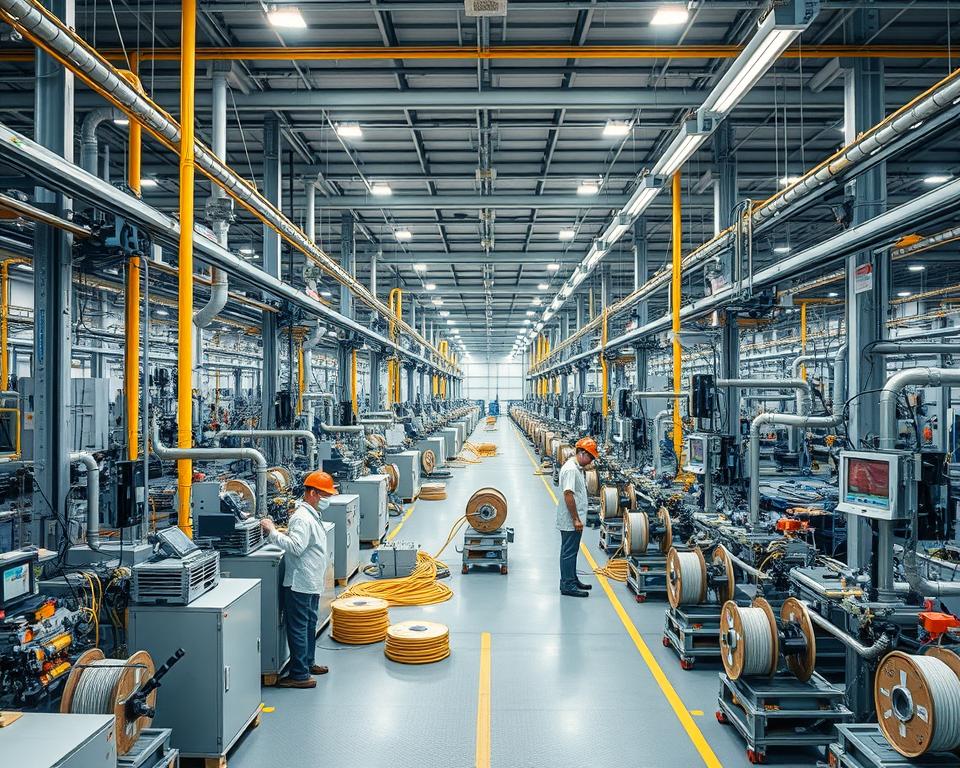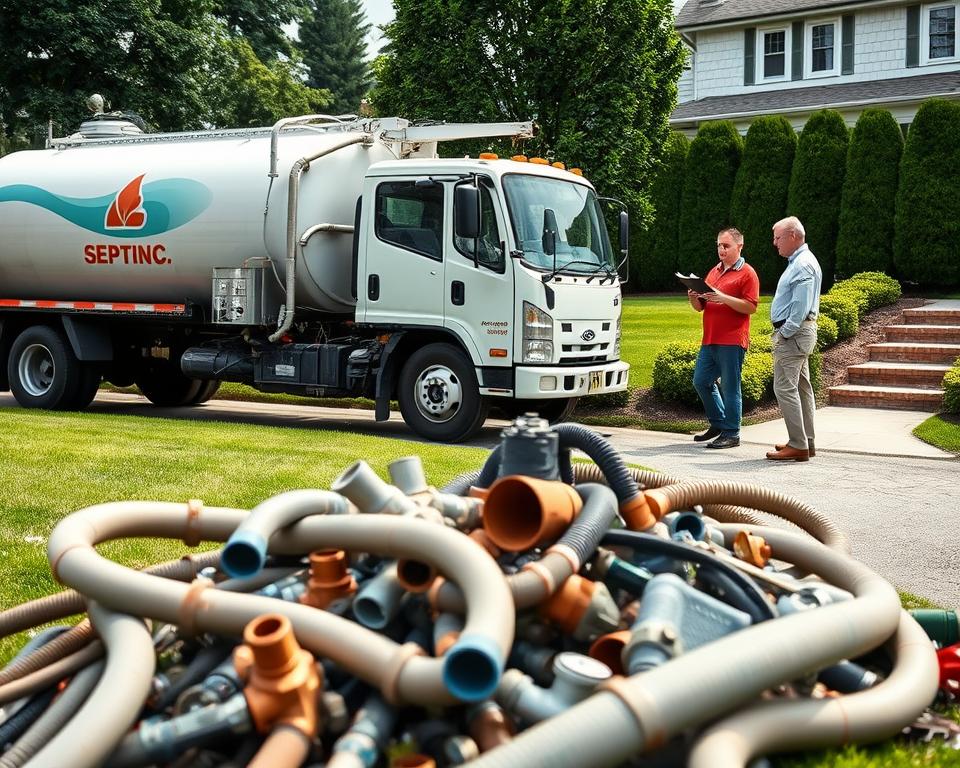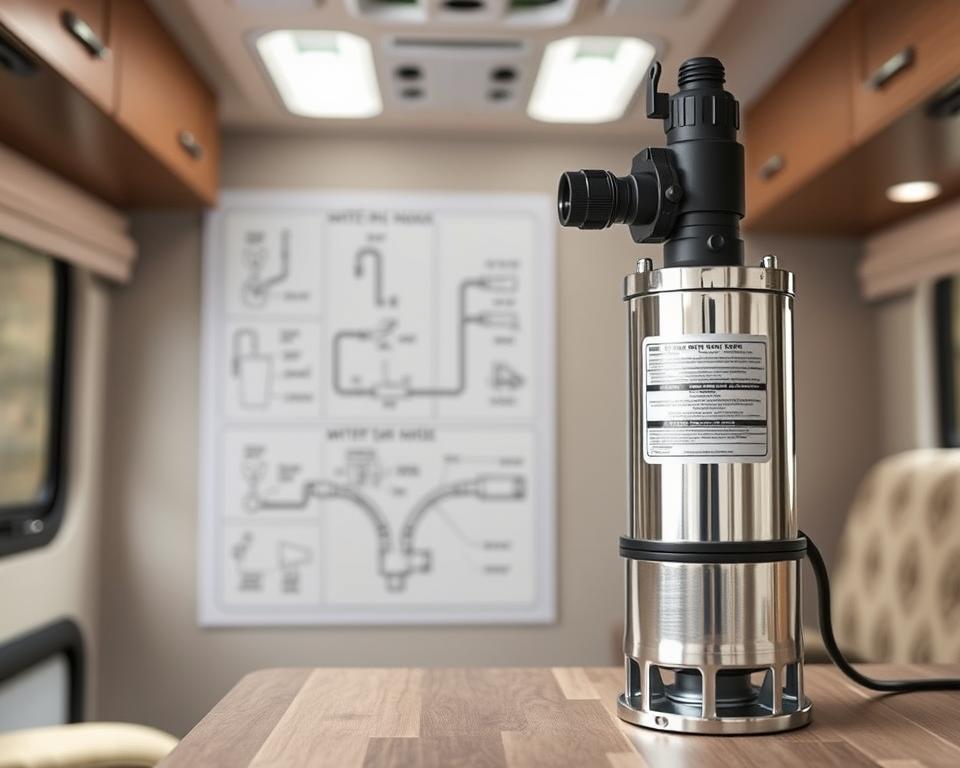The Essential Guide to FTTH cable Production Line
Allow us to present the essential guide to the FTTH cable production line. We will explore the world of fiber optic cables in this comprehensive article, focusing on their critical role in enabling high-speed data transmission. As the demand for internet connectivity that is both faster and more reliable keeps increasing, understanding the fine points of FTTH cable production becomes essential. This guide will furnish you with valuable insights into the production of fiber ribbone line, starting with the basics of cable infrastructure and moving through the step-by-step manufacturing process.
If you’re just starting out in the industry or want to improve your understanding, this guide is for you. We aim to explore the main parts of FTTH cable systems, the significance of optical fibers in FTTH technology, and the transformation of raw materials into high-quality fiber optic cables. Moreover, we will examine design considerations, stranding techniques, buffering and jacketing processes, and the efficient working of the FTTH cable production line.
Stay tuned for the advanced technologies transforming FTTH cable manufacturing, as well as the importance of testing and quality assurance in ensuring the reliability and durability of fiber optic cables. We’ll also discuss the last stages of packaging and distribution, making sure the FTTH cable production line works without any issues from start to finish.
Important Aspects:
- The FTTH cable production line is crucial in enabling high-speed data transmission.
- It’s crucial to understand the fundamentals of FTTH cable infrastructure and its main components.
- The step-by-step production of FTTH cable, starting with silica and resulting in fiber, includes fiber drawing, coating application, and testing.
- Designing configurations and layouts that meet specific network requirements can optimize performance.
- The fiber gains support and protection from stranding techniques and central strength members.
Fundamentals of FTTH cable Production
To truly understand the FTTH cable production process, a clear understanding of the cable infrastructure, main components, and the part played by optical fibers in FTTH technology is vital.
An Overview of the FTTH cable Infrastructure
The FTTH cable infrastructure is the system of cables, connectors, and distribution points that makes data transmission possible in fiber-to-the-home (FTTH) systems. The backbone of high-speed internet connectivity is formed by this infrastructure, which allows for seamless data transfer between the provider’s network and the end user’s location.

Main Parts of FTTH cable Systems
Several key components collaborate in FTTH cable systems to guarantee the smooth and efficient transmission of data. These components include:
- In the form of light, data signals are carried by these fiber optic cables. Their design focuses on high bandwidth and low signal loss, which guarantees fast and reliable data transmission.
- Crucially, connectors join fiber optic cables to other cables or devices, and they also make it easy to connect and disconnect cables when needed. Offering a secure and reliable connection, they minimize signal loss.
- Multiple end users receive divided and distributed fiber optic signals through the use of distribution points. Ensuring that each user gets the right amount of bandwidth without affecting the overall network performance is one of their functions.
How Optical Fibers Contribute to FTTH Technology
Optical fibers are fundamental to FTTH technology. Made of thin strands of glass or plastic, they are designed to efficiently transmit data signals in the form of light pulses. With their high bandwidth capacity, low signal loss, and immunity to electromagnetic interference, optical fibers are the perfect choice for high-speed data transmission.
The fibers are made of a core, which carries the light signals, surrounded by a cladding layer that reflects the light back into the core, preventing signal loss. Data can be transmitted over long distances by optical fibers without any reduction in signal quality or speed thanks to this construction.
How FTTH cable is Made: From Silica to Fiber
Creating the Core: The Fiber Drawing Process
Fiber drawing is the initial step in the FTTH cable production process, and it’s where the cable’s core is made. By pulling and stretching a silica glass preform, this process converts it into a long, thin fiber. The diameter of the fiber is precisely controlled during fiber drawing to guarantee optimal performance. The cable’s ability to transmit data efficiently and accurately is largely determined by the quality and composition of the core.
How Coating Application Ensures the cable’s Durability
Coating application is the step that follows fiber drawing. This stage involves applying a protective layer, which is called a coating, to the fiber. The coating serves multiple purposes: it acts as a buffer against external factors such as moisture, enhancing the fiber’s long-term durability and reliability. In addition, the coating material is chosen with care to ensure it has the correct mechanical properties, so the fiber will remain intact and protected throughout its lifespan.
Quality Control: Fiber Testing at Each Step
The quality and performance of the fiber are verified through fiber testing, which is done at different stages of the FTTH cable production process. During testing, the fiber’s physical parameters, like diameter, attenuation, and tensile strength, are measured, and the coating is checked for uniformity and how well it adheres. These tests are crucial for ensuring that the fiber meets the required standards and specifications, guaranteeing the overall quality and performance of the final FTTH cables.
| Production Stage |
Parameters Tested |
| Fiber Drawing |
Diameter, Attenuation, Tensile Strength |
| Coating Application |
Coating Thickness, Uniformity, Adhesion |
FTTH cable Production: Testing Parameters at Different Stages (Table)
The testing parameters measured at different stages of the FTTH cable production process are summarized in the table above. To ensure the high-performance and reliability of FTTH cable systems, manufacturers conduct rigorous testing to verify that every fiber used in the cables meets the required quality standards.
Creating FTTH cable Configurations
The design of cable configurations is a vital aspect of fiber-to-the-home (FTTH) cable production, as it helps meet network requirements and optimize performance. Factors like network capacity, how easily it can be expanded, and the desired speed of data transmission are all part of cable design. By tailoring cable configurations to specific needs, companies can ensure efficient deployment and maximize the capabilities of their network infrastructure.
FTTH cables offer a range of configurations and layouts, and each option comes with its own set of benefits and considerations:
- The Daisy Chain Configuration involves connecting each subscriber in a sequence to the main distribution point. It is a cost-effective solution suitable for areas with low subscriber density.
- Each subscriber has a direct connection to the central office or hub in the star configuration. It’s a flexible design that’s easy to maintain, making it ideal for areas with a high population density.
- In the ring configuration, subscribers are connected to form a circular loop. If the network fails, it still provides service without interruption because it has redundancy and can tolerate faults.
- The main distribution point connects to secondary distribution points, which then connect to individual subscribers in a tree configuration. Network expansion is efficient with this configuration, and it’s commonly used in areas with a high number of subscribers.
- With multiple connections between distribution points, the mesh configuration offers high reliability and redundancy. For applications where it’s essential that service never be interrupted, this configuration is commonly used.
It’s important to think about what the network needs and how much it’s expected to grow in the future when designing FTTH cable configurations. Because each configuration has its own set of benefits and limitations, the right one to select depends on factors like how many subscribers there are, the geographical location, and what services are in demand.
Working with industry experts and carefully assessing these factors allows companies to develop FTTH cable configurations that are customized to their unique network requirements and deliver the best possible performance.
Stranding Techniques and Equipment
The production of strong and durable FTTH cables relies heavily on the stranding techniques and equipment employed. Depending on what the cable needs to do, different stranding patterns are used, each with its own advantages. Selecting the correct stranding machinery is crucial for producing cables efficiently and to a high standard. Central strength members also play a role in providing extra support and protection to the fiber, which contributes to the overall reliability of the FTTH cables.
Various Stranding Patterns Explained
One of the key aspects of FTTH cable production is the selection of the appropriate stranding pattern. Reverse concentric, SZ stranding, and helical stranding are examples of the various stranding patterns used, depending on the cable’s desired characteristics. In terms of flexibility, strength, and how well it resists external factors, each pattern has unique features that can enhance the cable’s performance. To make sure the FTTH cables perform as well as possible and last a long time, stranding patterns are carefully chosen to meet the specific needs of the application.
Choosing the Right Stranding Machinery
Without stranding machinery, the FTTH cable production line wouldn’t function. By maintaining the required tension and alignment of the fibers, it makes it possible to precisely form the stranding pattern. When selecting the right fiber secondary coating line machinery, you need to consider things like the cable’s diameter, the speed of production, and the level of automation you need. With advanced stranding machines, manufacturers can be more efficient and flexible, which allows them to produce large quantities of cables and also customize them.
The Function of Central Strength Members
Central strength members are used in FTTH cables to enhance their mechanical properties. The delicate fiber within the cable is protected, and they also provide stability and enhance its tensile strength. Central strength members, which are usually made of materials like aramid or fiberglass, serve as a backbone, strengthening the cable structure and providing resistance against external forces. They ensure that FTTH cables can handle the stresses of being installed and that the signal transmission remains intact, making them appropriate for various deployment scenarios.
Protecting the Fiber: An Explanation of Buffering and Jacketing
During the production of FTTH cables, the buffering and jacketing processes are crucial for safeguarding the delicate fiber inside. These processes ensure that the fiber is shielded from an array of potential threats, including moisture, abrasion, and other external factors that could jeopardize its performance and longevity.
The Significance of Buffering in Fiber Protection
Applying a protective layer around the fiber is what the buffering process involves, and this layer acts as a barrier against environmental elements. This layer stops water from getting inside, which can cause the signal to be lost or even the fiber to break. The cable’s resistance to wear and tear is also improved by buffering, which reduces the risk of damage during installation or maintenance.
The buffering materials that are used must stick to the fiber excellently and have a low coefficient of friction to keep stress on the fiber to a minimum. The selection of the appropriate buffering material depends on factors such as the environmental conditions the cable will be subjected to and the desired level of protection.
Factors in Selecting Jacketing Materials
Putting an outer layer on to give extra protection to the fiber and the buffering materials is what jacketing involves. The jacketing material is specifically chosen to provide robust protection against mechanical stress, impact, UV radiation, and other potential hazards.
Factors such as flexibility, flame resistance, and compatibility with environmental conditions are considered when selecting jacketing materials. Some of the materials that are commonly used for jacketing include polyethylene (PE), polyvinyl chloride (PVC), and low-smoke zero-halogen (LSZH) compounds. Each material has its own set of advantages and disadvantages, and the choice depends on the specific application and industry standards.
The Application of Cutting-Edge Jacketing Technologies
Protecting FTTH cables has been completely changed by the latest improvements in jacketing technologies. With the newest technologies, you get better strength, more flexibility, and better resistance to things in the environment, which means they last longer and are more reliable.
Tight-buffered cables are one of the new jacketing technologies, and they involve buffering each fiber with a thin layer of plastic, which gives great protection and flexibility. Micro-ducts are another technology, and they use strong tubes to hold multiple fibers, which allows for high density and makes cable installation versatile.
Specialized jacketing technologies have also been developed to meet the unique requirements of various industries. As an example, cables that are used in tough outdoor environments might include armored jackets, which offer superior protection against rodents, moisture, and extreme temperatures.
The latest jacketing technologies make it possible to customize FTTH cables for various applications, ensuring they perform optimally, last a long time, and are reliable.
How the FTTH cable Production Line Works
The FTTH cable production line relies on efficient operations to ensure a smooth and streamlined manufacturing process. Producing high-quality fiber optic cables that allow for high-speed internet connectivity depends on each step in the production line playing a vital role. Optimal efficiency is reached by using a variety of machinery and equipment.
Preparation of raw materials, including the silica for fiber drawing, is the initial stage of the manufacturing process. After that, the fiber drawing process starts, and the cable’s core is carefully crafted to meet the desired specifications. Coating application is the next stage, and it ensures the fiber is durable and protected.
Because quality is so important, rigorous fiber testing is carried out at every stage of the production line to ensure the cables meet the highest standards. Factors such as attenuation, bandwidth, and signal loss are all tested as part of this process.
For the FTTH cable production line to work well, efficiency is very important. Using machinery and equipment in the most efficient way allows manufacturers to reduce production time and costs and also produce the maximum amount. Efficient processes also help to enhance the overall quality of the cables.
With its various stages and components, the manufacturing process can be quite complex. However, by using efficient operations and always trying to find ways to make things better, manufacturers can enhance the efficiency and effectiveness of their FTTH cable production line.
To provide a holistic understanding of the FTTH cable production line operations, the following table provides a summary of key machinery and their roles in the manufacturing process:
| Machine |
Role |
| Fiber Drawing Machine |
Produces the fiber optic cable core by pulling and stretching the silica material. |
| Coating Machine |
Applies a protective coating to the fiber optic cable, ensuring durability and resistance to external factors. |
| Fiber Testing Equipment |
Conducts various tests on the fiber optic cable to ensure quality and performance. |
| Spooling Machine |
Winds the finished fiber optic cable onto spools for packaging and distribution. |
| Jacketing Machine |
Applies an outer jacket to the fiber optic cable, providing additional protection and enhancing its handling. |
By leveraging advanced machinery and technologies, manufacturers can streamline their production line operations, enhance efficiency, and deliver high-quality FTTH cables that meet the increasing demand for high-speed internet connectivity.
Latest Technologies Used in FTTH cable Manufacturing
Advanced technologies are essential for enhancing efficiency and quality in the ever-changing field of FTTH (Fiber to the Home) cable manufacturing. The growing need for high-speed data transmission has led to automation, the integration of AI, and the use of fiber coloring machines, which have completely changed the production process, fostered innovation, and resulted in better products.
How Automation is Used in Fiber Optic cable Production
Automation has led to a major transformation in the manufacturing of fiber optic cables. With advanced machinery and robotics, the manufacturing process can be controlled with great precision, ensuring consistent quality and minimizing errors. Higher productivity, faster production, and better accuracy are all benefits of this automation, which ultimately leads to cost savings and enhanced customer satisfaction.
AI in Quality Control for cable Manufacturing
FTTH cable manufacturers can achieve accuracy and reliability like never before by using artificial intelligence (AI) in their quality control process. Algorithms powered by AI can analyze production data as it’s being generated, identifying any variations or problems that might impact the quality of the cables. Taking a proactive approach to quality control helps to reduce errors, make production more efficient, and ensure that only the highest quality FTTH cables are made available to customers.
The Benefits of Fiber Coloring Machines
The introduction of fiber coloring machines has revolutionized FTTH cable manufacturing by offering enhanced customization options. Color codes can be applied to optical fiber strands by fiber coloring machines, which allows for easy identification and makes cable management more efficient during installation and maintenance. By using this technology, manual color coding is no longer needed, which reduces the chance of errors and makes the entire process of deploying cables more efficient.
Quality Assurance in Fiber Optics: The Importance of Testing
In the world of fiber optics, ensuring the highest quality is of utmost importance. This goal is reached by implementing thorough testing and quality assurance measures at every stage of the production process. Playing a crucial role, standardized testing protocols guarantee the reliability and consistency of fiber optic cables.
Using Standardized Testing Procedures
Every fiber optic cable is guaranteed to meet the required quality standards through the establishment of standardized testing protocols. At each stage of the production process, these protocols specify the testing procedures and criteria that must be followed. Manufacturers can find and fix any problems by following these protocols, which ensures that customers only receive the best quality cables.
OTDR: A Key Tool for Quality Checks
Optical Time-Domain Reflectometer (OTDR) is an essential tool for checking the quality of fiber optic cables. OTDR is a testing instrument that utilizes light pulses to measure the loss and reflectance along the length of an optical fiber. Looking at the OTDR traces allows technicians to find issues such as when the fiber is bent, signal is lost, or connectors are damaged. This enables them to pinpoint the exact location of any faults and take corrective actions, ensuring the overall quality and performance of the cable.
Steps to Maintain Rigorous Quality Assurance Standards
Quality assurance standards are maintained throughout the entire production process to ensure consistent and reliable performance of fiber optic cables. Various aspects are covered by these standards, including the selection of materials, the manufacturing processes used, and the testing of the final product. These rigorous standards help manufacturers ensure that their products achieve the highest levels of quality and performance that the industry requires.
The Last Steps: Packaging and Distribution of FTTH cables
Packaging and distribution, the final steps in SZ stranding line production, are what this section is about. After the cables have undergone the various manufacturing processes, it is crucial to ensure that they are packaged correctly and efficiently to facilitate their deployment and installation in the field. In addition, using packaging that protects them is crucial for keeping the delicate fiber optic cables safe during transportation and storage. Efficient logistics and supply chain management are essential to ensuring that FTTH products are delivered to customers in a timely manner, meeting their connectivity needs effectively.
Efficient cable Spooling Techniques
For FTTH cables to be installed smoothly and easily, efficient techniques for spooling them are vital. By providing a practical and organized way to store and transport cables, cable spools reduce the risk of tangling or damage. cable installers can save time and effort when deploying cables by using the best cable spooling techniques. The overall look of the installation is also enhanced by properly spooled cables, which ensures a neat and professional appearance.
Best Packaging Practices for Fiber Optic cables
The delicate fiber optic cables need to be protected during transportation and storage, and this requires the implementation of effective protective packaging solutions. These packaging solutions should cushion the cables, absorb shocks, and protect them from things outside like moisture, dust, and being hit. By utilizing high-quality packaging materials and techniques, manufacturers can ensure that the fiber optic cables arrive at their destination in optimal condition, ready for installation. The integrity of the cables is protected, and customer satisfaction is also enhanced by minimizing the risk of damage or the cables not working properly.
How Logistics and Supply Chain Management Affect FTTH Products
The successful delivery of FTTH products to customers depends on efficient logistics and supply chain management. This includes making careful plans for how the cables will be transported, stored, and distributed to ensure they arrive when they should and are reliable. This helps to keep delays to a minimum and makes the flow of products better, which reduces costs and enhances customer service, all thanks to effective supply chain management..
Final Thoughts
To conclude, this ultimate guide to the FTTH cable production line has given a complete overview of how fiber optic cables for high-speed internet connectivity are manufactured. This article has emphasized the crucial role of the FTTH cable production line in enabling data transmission that is fast and reliable.
Playing a critical role in high-speed internet connectivity, fiber optic cables allow for seamless communication, streaming, and online activities. Ensuring the durability and quality of these cables is the result of the step-by-step process of FTTH cable production, which includes fiber drawing, buffering, and jacketing.
Efficiency and accuracy in the manufacturing process have been increased thanks to advanced technologies such as automation and AI integration, which have revolutionized it. Also, the reliability and performance of fiber optics are guaranteed by following standardized testing protocols and strict quality assurance standards.
Making sure these essential cables are deployed efficiently and protected during transportation is the purpose of the final steps in FTTH cable production: packaging and distribution. Overall, the expertise and precision involved in the FTTH cable production line are essential in meeting the increasing demand for high-speed internet connectivity around the world.










